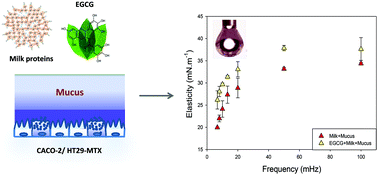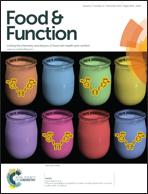Interfacial dilational properties of tea polyphenols and milk proteins with gut epithelia and the role of mucus in nutrient adsorption
Abstract
By interacting with nutrients, the mucus layer covering the intestinal epithelium may mediate absorption. This study aimed to determine possible interactions between epigallocatechin-3-gallate (EGCG), skim milk proteins or their complexes with human intestinal mucin films. The films were extracted from postconfluent monolayers of HT29-MTX, a human intestinal cell line, and a model system was created using drop shape tensiometry. The EGCG uptake tested in vitro on postconfluent Caco-2 cells or co-cultures of Caco-2/HT29-MTX (mucus producing) showed recovery of bioavailable EGCG only for Caco-2 cell monolayers, suggesting an effect of mucus on absorption. Interfacial dilational rheology was employed to characterize the properties of the interface mixed with mucus dispersion. Adsorption of polyphenols greatly enhanced the viscoelastic modulus of the mucus film, showing the presence of interactions between the nutrient molecules and mucus films. On the other hand, in situ digestion of milk proteins using trypsin showed higher surface activities as a result of protein unfolding and competitive adsorption of the hydrolyzed products. There was an increase of viscoelastic modulus over the drop ageing time for the mixed interfaces, indicating the formation of a stiffer interfacial network. These results bring new insights into the role of the mucus layer in nutrient absorption and the interactions of mucus and dairy products.

- This article is part of the themed collection: Probiotics, Prebiotics and Gut Health

 Please wait while we load your content...
Please wait while we load your content...